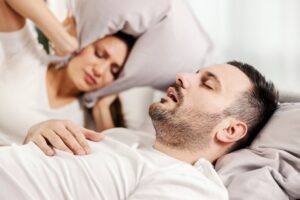Obstructive Sleep Apnea vs. Palatal Snoring
 Although some believe that snoring and sleep apnea are one and the same, this is actually a falsehood. It’s true that both conditions can disrupt sleep – but when it comes to causes, risks, and potential solutions, a few key differences set them apart.
Although some believe that snoring and sleep apnea are one and the same, this is actually a falsehood. It’s true that both conditions can disrupt sleep – but when it comes to causes, risks, and potential solutions, a few key differences set them apart.
Firstly, let’s look at obstructive sleep apnea (or “OSA”). This sleep disorder is characterized by repeated interruptions in breathing throughout the night, which occur when the muscles in the back of the throat fail to keep the airway open. As a result of these pauses in breath, blood oxygen levels can fluctuate significantly, paving the way for problems like fatigue, hypertension, and even heart disease.*
While snoring is a common symptom of sleep apnea, not everyone who snores will have the condition. Rather, “palatal snoring” refers to the typical snoring that many people experience, which is caused by the vibration of the soft palate and uvula during sleep. Palatal snoring is less likely to lead to serious health issues, but can still be a nuisance and have negative effects on sleep quality.
Thankfully, advanced treatments like Solea Sleep can reduce the severity of palatal snoring*; however, management of OSA is usually a bit more in-depth and requires a sleep study for diagnosis. If you’re unsure whether you’re up against everyday snoring or sleep apnea, feel free to book a consultation with our friendly team at Austin Dental Spa!
